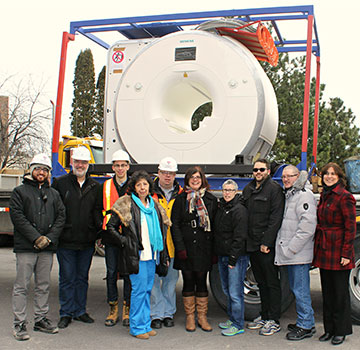A long-awaited gift arrives just in time for the holidays at Lachine Hospital
"This is a major event," said staff members of the Lachine Hospital of the McGill University Health Centre (LH-MUHC) as they watched the arrival of a magnetic resonance imaging (MRI) scanner specifically adapted for people suffering from morbid obesity or claustrophobia. Like an enormous Christmas present wrapped in red plastic, the machine was installed through the roof with the help of a crane, on November 30.

From left to right: Mohamed Merheb, section manager, Technical Services; Jean Bergeron, supervising worksite technician, Tetra Tech; Hugo Castonguay, architectural techniques trainee; Paula Abi Nakhlé, project manager; Claude Briault, site coordinator for Technical Services; Julie Dumaine, chief of Medical Imaging; Sylvie Landry, assistant head of Medical Imaging; Florence Clerc, Medical Imaging technician; Karl Bissonnette, Medical Imaging technician; and Éric Paiement, Medical Imaging technician.
"Despite the fact that Lachine Hospital is a recognized centre of excellence in bariatric surgery in Quebec, our patients had to go elsewhere to have an MRI," explains Julie Dumaine, chief of the Medical Imaging Department at Lachine. "This new machine will allow us to serve not only our patients, but also obese and claustrophobic patients from McGill University’s Réseau Universitaire Intégré de Santé (RUIS McGill)." As part of the MUHC, the Lachine Hospital offers bariatric surgery services to the entire RUIS McGill territory, which covers 63 per cent of Quebec and serves 1.8 million people.
MRI machines use a powerful magnetic field and radio-frequency waves to create high-quality images of the inside of the human body in three different planes. They can also reconstruct higher level images that can then be interpreted by a radiologist. The procedure is painless: the patient lies on a table that slides into a tunnel. At Lachine, the set-up was designed to minimize the feeling of confinement that can cause considerable distress to people with claustrophobia.
"Our team planned everything to be oversized, well lit and comfortable for our patients," says Dumaine.
A long-awaited project
Construction of the new unit involved the creation of an MRI room, a control room, a reception and waiting area, as well as rooms where patients are prepped and where radiologists interpret images. The project, which combined efforts from the departments of Technical Services, Medical Imaging, Infection Prevention and Control and a project manager, was put on hold several times before finally getting the definitive green light at the end of 2014. In order to make room for the new unit, the cardiology and respiratory therapy departments had to move to the third floor, which had been left vacant following the prior move of administrative offices to the fourth floor.
"These changes have had a significant impact in many areas of the hospital," adds Dumaine. "So we're working hard to complete the project and we're all looking forward to the result."
The new MRI unit of Lachine Hospital’s Medical Imaging Service will be inaugurated in mid-January.
